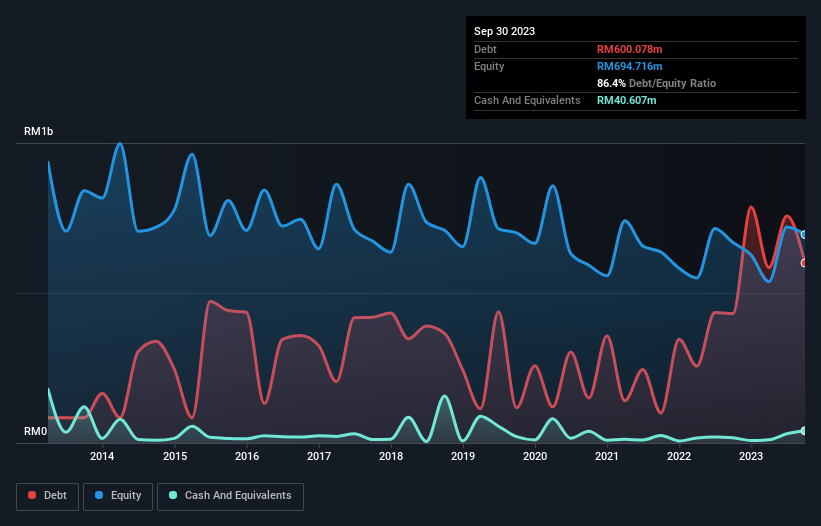We Think Nestlé (Malaysia) Berhad (KLSE:NESTLE) Can Stay On Top Of Its Debt

Warren Buffett famously said, 'Volatility is far from synonymous with risk.' So it might be obvious that you need to consider debt, when you think about how risky any given stock is, because too much debt can sink a company. We note that Nestlé (Malaysia) Berhad (KLSE:NESTLE) does have debt on its balance sheet. But should shareholders be worried about its use of debt?
When Is Debt Dangerous?
Debt is a tool to help businesses grow, but if a business is incapable of paying off its lenders, then it exists at their mercy. Part and parcel of capitalism is the process of 'creative destruction' where failed businesses are mercilessly liquidated by their bankers. While that is not too common, we often do see indebted companies permanently diluting shareholders because lenders force them to raise capital at a distressed price. Of course, the upside of debt is that it often represents cheap capital, especially when it replaces dilution in a company with the ability to reinvest at high rates of return. The first step when considering a company's debt levels is to consider its cash and debt together.
See our latest analysis for Nestlé (Malaysia) Berhad
What Is Nestlé (Malaysia) Berhad's Net Debt?
You can click the graphic below for the historical numbers, but it shows that as of September 2023 Nestlé (Malaysia) Berhad had RM600.1m of debt, an increase on RM431.4m, over one year. However, it also had RM40.6m in cash, and so its net debt is RM559.5m.

How Strong Is Nestlé (Malaysia) Berhad's Balance Sheet?
Zooming in on the latest balance sheet data, we can see that Nestlé (Malaysia) Berhad had liabilities of RM2.16b due within 12 months and liabilities of RM660.5m due beyond that. On the other hand, it had cash of RM40.6m and RM525.5m worth of receivables due within a year. So its liabilities outweigh the sum of its cash and (near-term) receivables by RM2.26b.
Given Nestlé (Malaysia) Berhad has a market capitalization of RM28.4b, it's hard to believe these liabilities pose much threat. Having said that, it's clear that we should continue to monitor its balance sheet, lest it change for the worse.
We measure a company's debt load relative to its earnings power by looking at its net debt divided by its earnings before interest, tax, depreciation, and amortization (EBITDA) and by calculating how easily its earnings before interest and tax (EBIT) cover its interest expense (interest cover). Thus we consider debt relative to earnings both with and without depreciation and amortization expenses.
Nestlé (Malaysia) Berhad has a low net debt to EBITDA ratio of only 0.50. And its EBIT easily covers its interest expense, being 33.9 times the size. So you could argue it is no more threatened by its debt than an elephant is by a mouse. The good news is that Nestlé (Malaysia) Berhad has increased its EBIT by 9.3% over twelve months, which should ease any concerns about debt repayment. There's no doubt that we learn most about debt from the balance sheet. But ultimately the future profitability of the business will decide if Nestlé (Malaysia) Berhad can strengthen its balance sheet over time. So if you're focused on the future you can check out this free report showing analyst profit forecasts.
Finally, a business needs free cash flow to pay off debt; accounting profits just don't cut it. So it's worth checking how much of that EBIT is backed by free cash flow. Over the most recent three years, Nestlé (Malaysia) Berhad recorded free cash flow worth 63% of its EBIT, which is around normal, given free cash flow excludes interest and tax. This free cash flow puts the company in a good position to pay down debt, when appropriate.
Our View
Nestlé (Malaysia) Berhad's interest cover suggests it can handle its debt as easily as Cristiano Ronaldo could score a goal against an under 14's goalkeeper. And the good news does not stop there, as its net debt to EBITDA also supports that impression! Looking at the bigger picture, we think Nestlé (Malaysia) Berhad's use of debt seems quite reasonable and we're not concerned about it. While debt does bring risk, when used wisely it can also bring a higher return on equity. There's no doubt that we learn most about debt from the balance sheet. But ultimately, every company can contain risks that exist outside of the balance sheet. For instance, we've identified 2 warning signs for Nestlé (Malaysia) Berhad that you should be aware of.
If, after all that, you're more interested in a fast growing company with a rock-solid balance sheet, then check out our list of net cash growth stocks without delay.
Valuation is complex, but we're here to simplify it.
Discover if Nestlé (Malaysia) Berhad might be undervalued or overvalued with our detailed analysis, featuring fair value estimates, potential risks, dividends, insider trades, and its financial condition.
Access Free AnalysisHave feedback on this article? Concerned about the content? Get in touch with us directly. Alternatively, email editorial-team (at) simplywallst.com.
This article by Simply Wall St is general in nature. We provide commentary based on historical data and analyst forecasts only using an unbiased methodology and our articles are not intended to be financial advice. It does not constitute a recommendation to buy or sell any stock, and does not take account of your objectives, or your financial situation. We aim to bring you long-term focused analysis driven by fundamental data. Note that our analysis may not factor in the latest price-sensitive company announcements or qualitative material. Simply Wall St has no position in any stocks mentioned.
About KLSE:NESTLE
Nestlé (Malaysia) Berhad
Manufactures and sells food and beverage products in Malaysia and internationally.
Moderate growth potential with mediocre balance sheet.
Market Insights
Community Narratives



